Favorite Parts of a Single Leaf for Giant Flying Squirrels to Eat in Three Species of Food Trees
Abstract
:Simple Summary
Abstract
1. Introduction
2. Materials and Methods
2.1. Leaf Debris Collection
2.2. Leaf Chemical Analysis between Summer and Winter
2.3. Microscale Distribution of Leaf Chemicals
2.4. Statistics
3. Results
3.1. Seasonal Changes in Leaf Debris
3.2. Feeding Pattern
3.3. Leaf Chemicals between Summer and Winter
3.4. Microscale Distributions of Leaf Chemicals
4. Discussion
4.1. Preferred Tree Species and Chemical Composition
4.2. Favorite Parts of a Leaf and Microscale Chemical Distributions
5. Conclusions
Author Contributions
Funding
Institutional Review Board Statement
Informed Consent Statement
Data Availability Statement
Acknowledgments
Conflicts of Interest
References
- Schaefer, H.M.; Ruxton, G.D. Plant-Animal Communication; Oxford University Press: Oxford, UK, 2011; p. 296. [Google Scholar]
- Farmer, E.E. Leaf Defence; Oxford University Press: Oxford, UK, 2014; p. 216. [Google Scholar]
- Ganzhorn, J.U.; Arrigo-Nelson, S.J.; Carrai, V.; Chalise, M.K.; Donati, G.; Droescher, I.; Eppley, T.M.; Irwin, M.T.; Koch, F.; Koenig, A. The importance of protein in leaf selection of folivorous primates. Am. J. Primatol. 2017, 79, 1–13. [Google Scholar] [CrossRef] [PubMed]
- Ito, M.; Hayashi, F. Tree-leaf chemicals and feeding behavior of arboreal mammals in seasonal environment. In Co-Evolution of Secondary Metabolites, Reference Series in Phytochemistry; Mérillon, J.-M., Ramawat, K.G., Eds.; Springer Nature: Cham, Switzerland, 2020; pp. 345–376. [Google Scholar]
- Windley, H.R.; Starrs, D.; Stalenberg, E.; Rothman, J.M.; Ganzhorn, J.U.; Foley, W.J. Plant secondary metabolites and primate food choices: A meta-analysis and future directions. Am. J. Primatol. 2022, 84, e23397. [Google Scholar] [CrossRef] [PubMed]
- Lu, H.-P.; Wang, Y.; Huang, S.-W.; Lin, C.-Y.; Wu, M.; Hsieh, C.; Yu, H.-T. Metagenomic analysis reveals a functional signature for biomass degradation by cecal microbiota in the leaf-eating flying squirrel (Petaurista alborufus lena). BMC Genom. 2012, 13, 466. [Google Scholar] [CrossRef]
- Matsuda, I.; Bernard, H.; Tuuga, A.; Nathan, S.K.S.S.; Sha, J.C.M.; Osman, I.; Sipangkui, R.; Seino, S.; Asano, S.; Wong, A.; et al. Fecal nutrients suggest diets of higher fiber levels in free-ranging than in captive proboscis monkeys (Nasalis larvatus). Front. Vet. Sci. 2018, 4, 246. [Google Scholar] [CrossRef]
- Omori, A.; Abe, N.; Hosoi, E. Distribution of tannins as defensive chemicals in plant resources: The potential for ingestion by mammals. Mamm. Sci. 2023, 63, 193–214. (In Japanese) [Google Scholar]
- Glander, K.E. The impact of plant secondary compounds on primate feeding behavior. Am. J. Phys. Anthropol. 1982, 25, 1–18. [Google Scholar] [CrossRef]
- Garber, P.A. Foraging strategies among living primates. Annu. Rev. Anthropol. 1987, 16, 339–364. [Google Scholar] [CrossRef]
- Provenza, F.D.; Villalba, J.J.; Dziba, L.E.; Atwood, S.B.; Banner, R.E. Linking herbivore experience, varied diets, and plant biochemical diversity. Small Rumin. Res. 2003, 49, 257–274. [Google Scholar] [CrossRef]
- Ito, M.; Seto, N.; Rico, B.; Shigeta, M.; Tamura, N.; Hayashi, F. Folivory with leaf folding by giant flying squirrels: Its patterns and possible function. Ecol. Res. 2016, 31, 617–626. [Google Scholar] [CrossRef]
- Ito, M.; Tamura, N.; Hayashi, F. Seasonal changes in leaf chemistry and leaf selection of the Japanese giant flying squirrel upon two tree species. Ecol. Evol. 2017, 7, 5766–5773. [Google Scholar] [CrossRef]
- Ohdachi, S.D.; Ishibashi, Y.; Iwasa, M.A.; Fukui, D.; Saitoh, T. The Wild Mammals of Japan, 2nd ed.; Shoukadoh Book Sellers: Kyoto, Japan, 2015; p. 506. [Google Scholar]
- Steele, M.A.; Knowles, T.; Bridle, K.; Simms, E.L. Tannins and partial consumption of acorns: Implications for dispersal of oaks by seed predators. Am. Midl. Nat. 1993, 130, 229–238. [Google Scholar] [CrossRef]
- Yang, Y.; Yi, X. Partial acorn consumption by small rodents: Implication for regeneration of white oak, Quercus mongolica. Plant Ecol. 2012, 213, 197–205. [Google Scholar] [CrossRef]
- Mikuriya, M. Fauna in the Tama Forest Science Garden. Bull. For. For. Prod. Res. Inst. 1993, 74, 1101–1116. (In Japanese) [Google Scholar]
- Tamura, N. Effects of habitat mosaic on home range size of the Japanese squirrel, Sciurus lis. Mammal Study 2004, 29, 9–14. [Google Scholar] [CrossRef]
- Nurmi, K.; Ossipov, V.; Haukioja, E.; Pihlaja, K. Variation of total phenolic content and individual low-molecular-weight phenolics in foliage of mountain Birch trees (Betula pubescens ssp. tortuosa). J. Chem. Ecol. 1996, 22, 2023–2040. [Google Scholar] [CrossRef] [PubMed]
- Zuur, A.F.; Ieno, E.N.; Elphick, C.S. A protocol for data exploration to avoid common statistical problems. Methods Ecol. Evol. 2010, 1, 3–14. [Google Scholar] [CrossRef]
- R Core Team. R: A Language and Environment for Statistical Computing; R Foundation for Statistical Computing: Vienna, Austria, 2021; Available online: https://www.R-project.org (accessed on 8 January 2023).
- Shigeta, M.; Shigeta, Y.; Tamura, N. Habitat use of giant flying squirrels, Petaurista leucogenys, by collecting their field tracks. J. Jpn. Wild Res. Soc. 2010, 35, 13–21. (In Japanese) [Google Scholar]
- Harborne, J.B. The chemical basis of plant defence. In Plant Defenses against Mammalian Herbivory; Palo, R.T., Robbins, C.T., Eds.; CRC Press: Boca Raton, FL, USA, 1991; pp. 45–59. [Google Scholar]
- Bryant, J.P.; Reichardt, P.B.; Clausen, T.P.; Provenza, F.D.; Kuropat, P.J. Woody plant-mammal interactions. In Herbivores: Their Interactions with Secondary Plant Metabolites; Rosental, G.A., Berembaum, M.R., Eds.; Academic Press: San Diego, CA, USA, 1992; pp. 344–371. [Google Scholar]
- Shimada, T. Salivary proteins as a defense against dietary tannins. J. Chem. Ecol. 2006, 32, 1149–1163. [Google Scholar] [CrossRef]
- Barbehenn, R.V.; Constabel, C.P. Tannins in plant–herbivore interactions. Phytochemistry 2011, 72, 1551–1565. [Google Scholar] [CrossRef]
- Iason, G.R.; Villalba, J.J. Behavioral strategies of mammal herbivores against plant secondary metabolites: The avoidance–tolerance continuum. J. Chem. Ecol. 2006, 32, 1115–1132. [Google Scholar] [CrossRef]
- Lemon, C.H. Perceptual and neural responses to sweet taste in humans and rodents. Chemosens. Percept. 2015, 8, 46–52. [Google Scholar] [CrossRef] [PubMed]
- Teaford, M.F.; Lucas, P.W.; Ungar, P.S.; Glander, K.E. Mechanical defenses in leaves eaten by Costa Rican howling monkeys (Alouatta palliata). Am. J. Physic. Anthropol. 2006, 129, 99–104. [Google Scholar] [CrossRef] [PubMed]
- Hanley, M.E.; Lamont, B.B.; Fairbanks, M.M.; Rafferty, C.M. Plant structural traits and their role in anti-herbivore defence. Perspec. Plant Ecol. Evol. Syst. 2007, 8, 157–178. [Google Scholar] [CrossRef]
- Shimada, T.; Nishii, E.; Saitoh, T. Interspecific differences in tannin intakes of forest-dwelling rodents in the wild revealed by a new method using fecal proline content. J. Chem. Ecol. 2011, 37, 1277–1284. [Google Scholar] [CrossRef]
- Windley, H.R.; Shimada, T. Cold temperature improves tannin tolerance in a granivorous rodent. J. Anim. Ecol. 2020, 89, 471–481. [Google Scholar] [CrossRef]
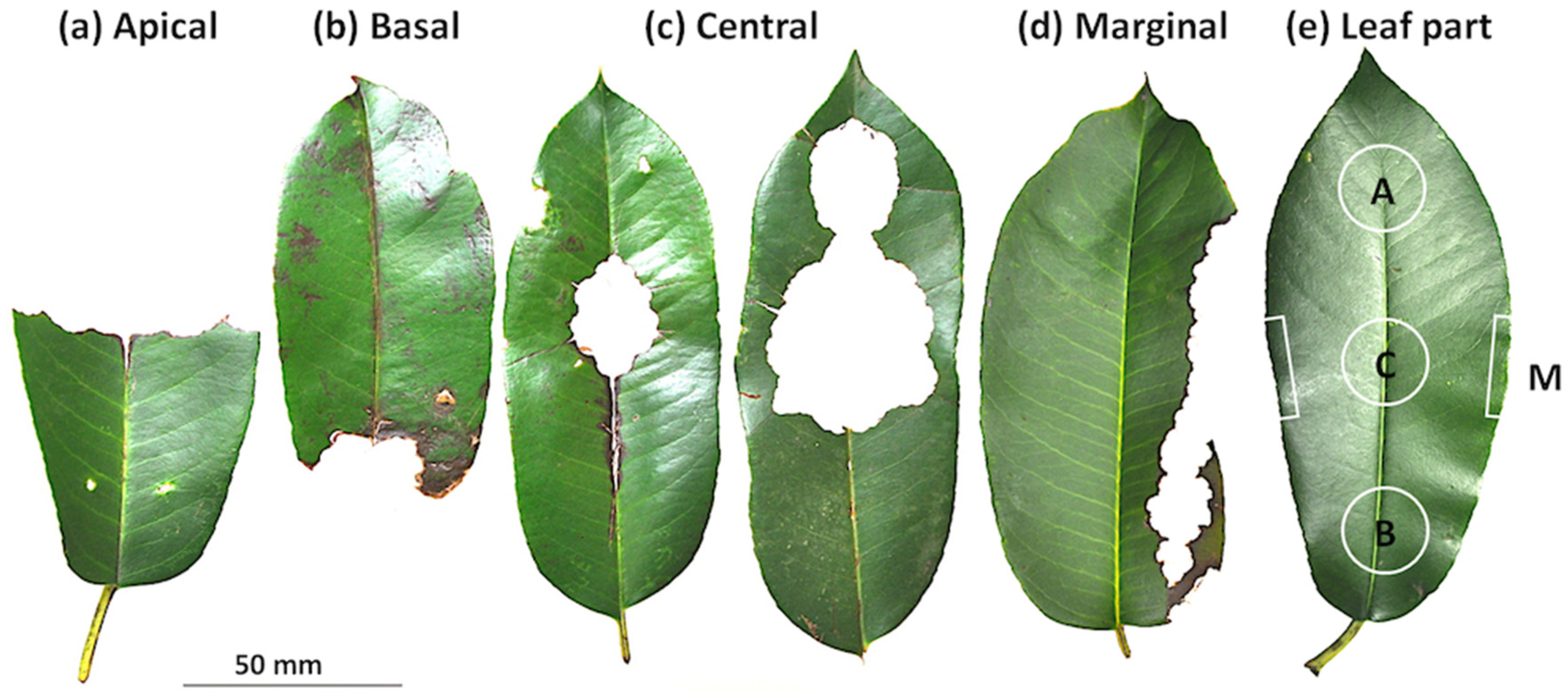
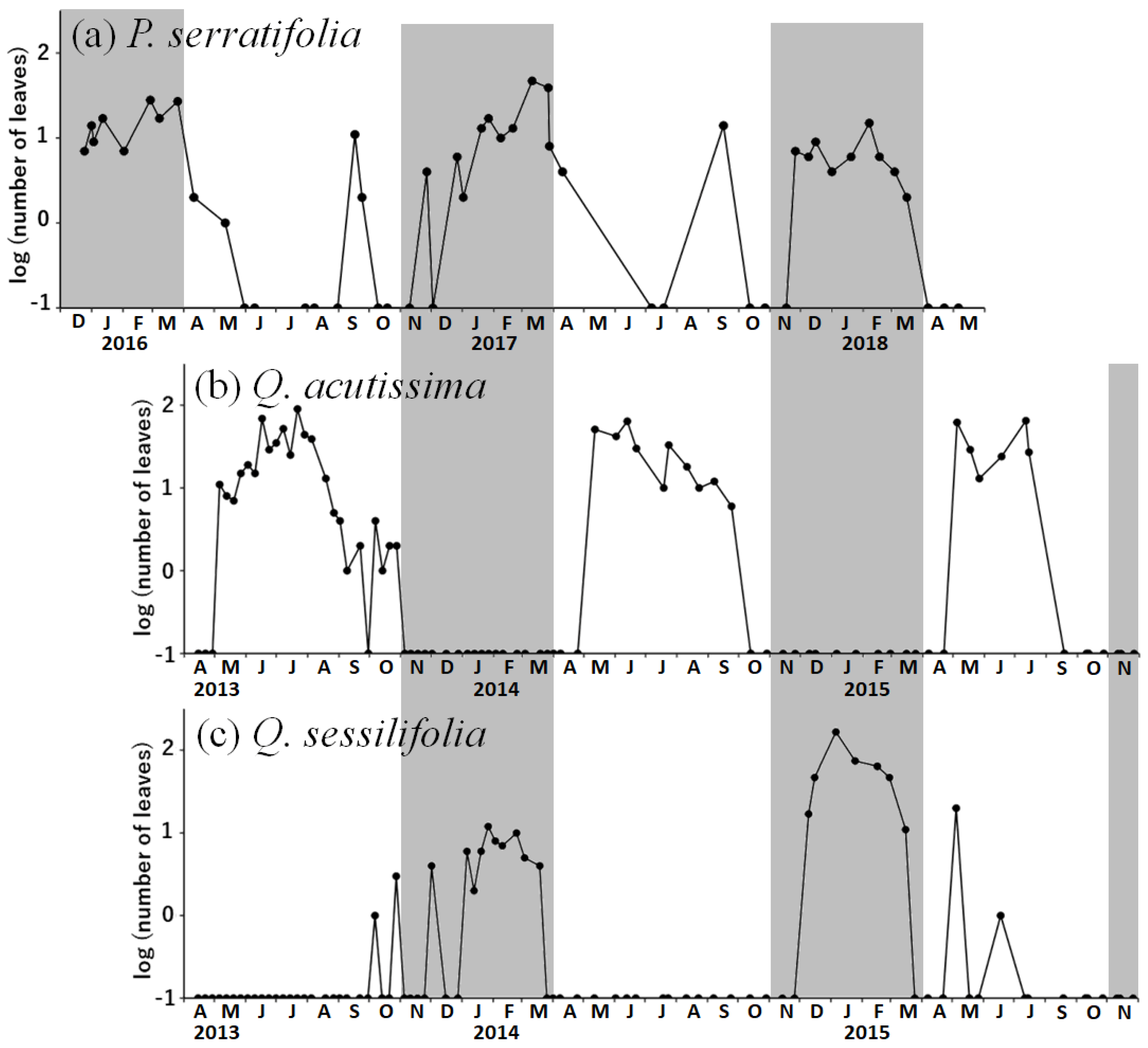

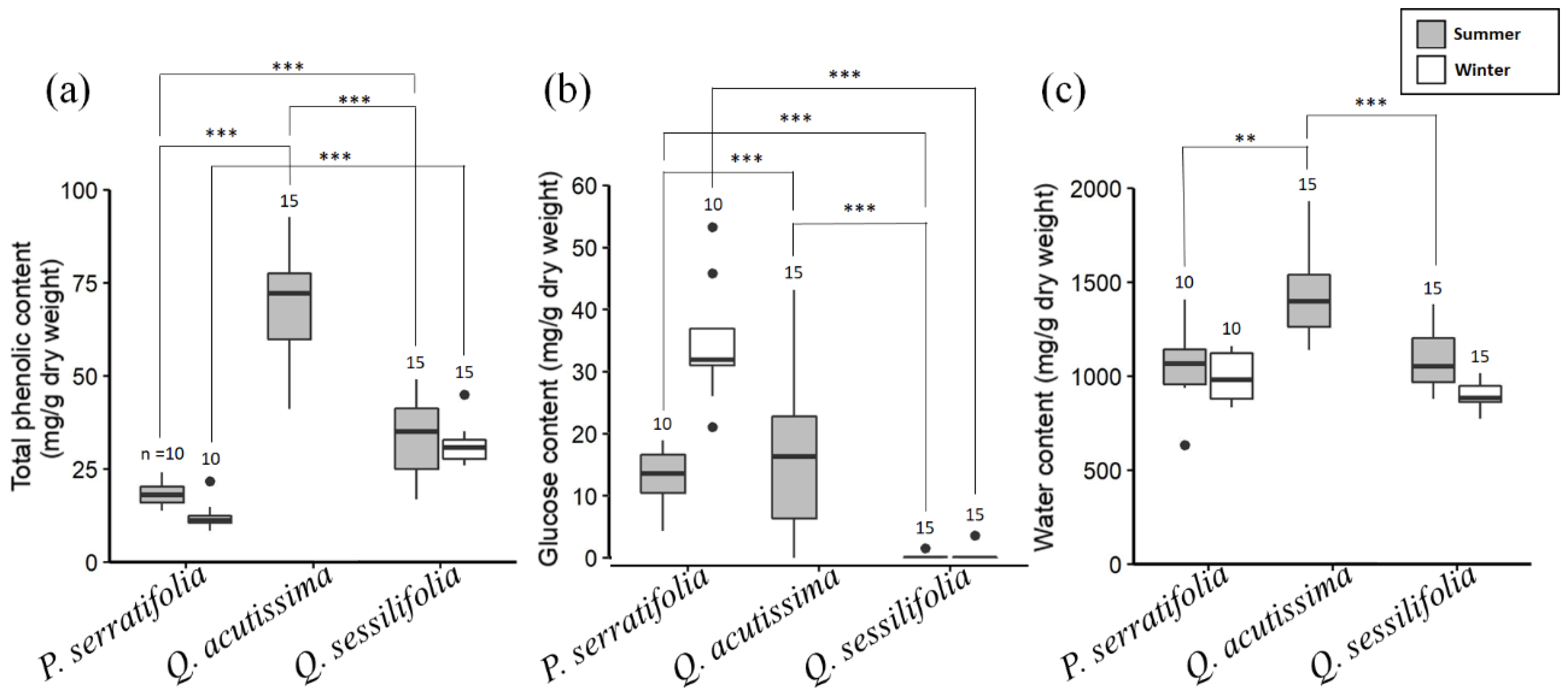
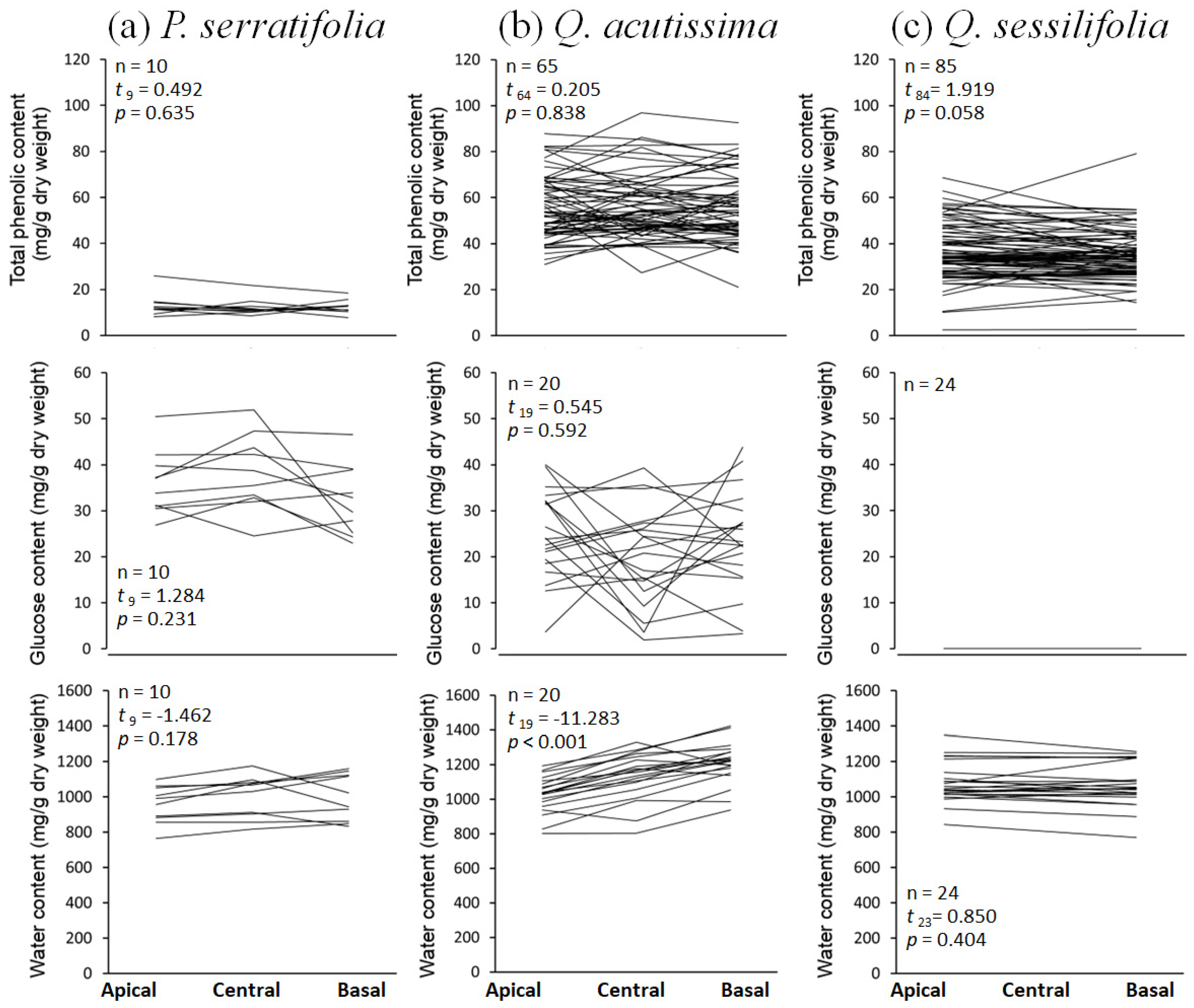
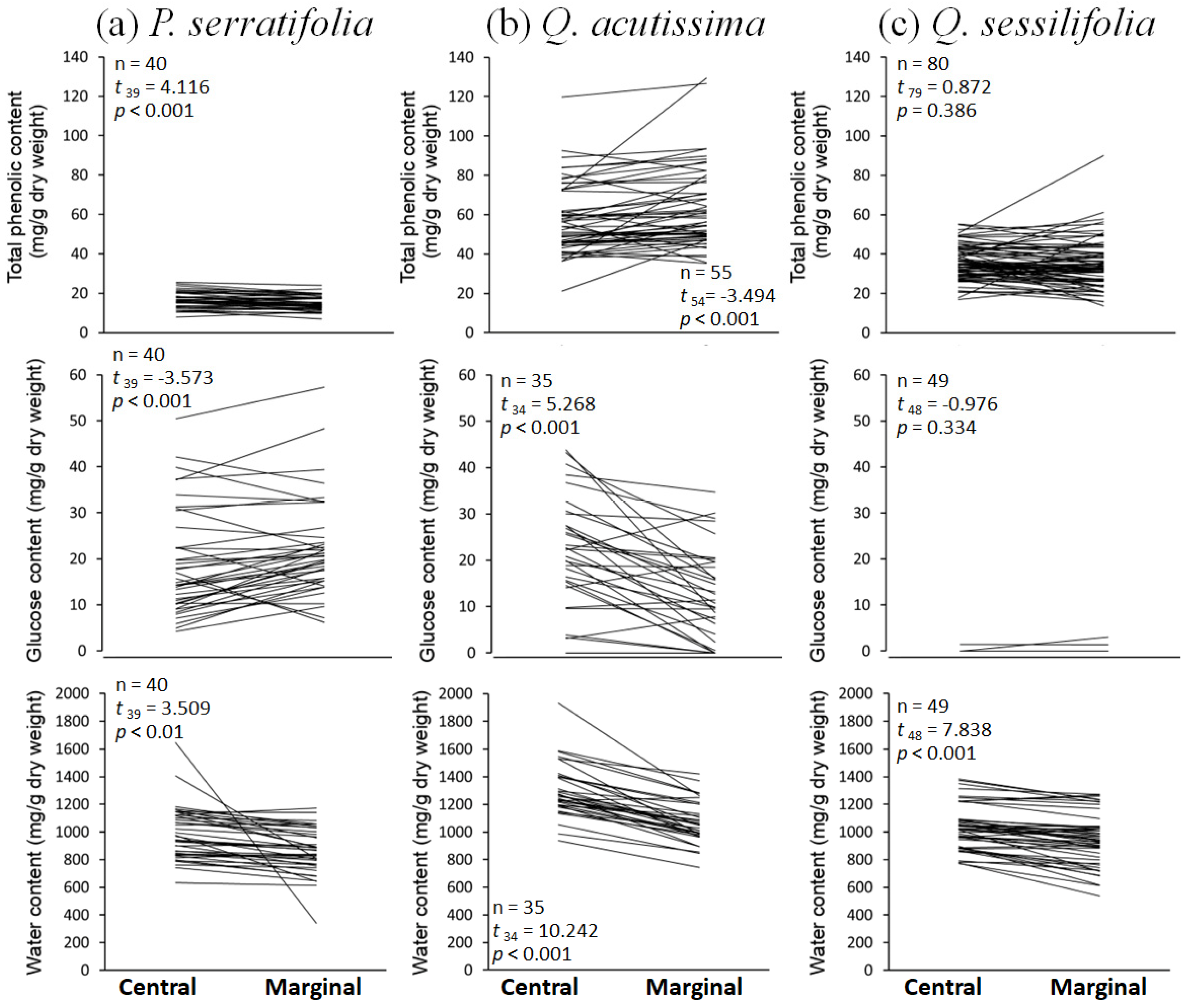
Disclaimer/Publisher’s Note: The statements, opinions and data contained in all publications are solely those of the individual author(s) and contributor(s) and not of MDPI and/or the editor(s). MDPI and/or the editor(s) disclaim responsibility for any injury to people or property resulting from any ideas, methods, instructions or products referred to in the content. |
© 2023 by the authors. Licensee MDPI, Basel, Switzerland. This article is an open access article distributed under the terms and conditions of the Creative Commons Attribution (CC BY) license (https://creativecommons.org/licenses/by/4.0/).
Share and Cite
Ito, M.; Tamura, N.; Hayashi, F. Favorite Parts of a Single Leaf for Giant Flying Squirrels to Eat in Three Species of Food Trees. Biology 2023, 12, 1352. https://doi.org/10.3390/biology12101352
Ito M, Tamura N, Hayashi F. Favorite Parts of a Single Leaf for Giant Flying Squirrels to Eat in Three Species of Food Trees. Biology. 2023; 12(10):1352. https://doi.org/10.3390/biology12101352
Chicago/Turabian StyleIto, Mutsumi, Noriko Tamura, and Fumio Hayashi. 2023. "Favorite Parts of a Single Leaf for Giant Flying Squirrels to Eat in Three Species of Food Trees" Biology 12, no. 10: 1352. https://doi.org/10.3390/biology12101352
APA StyleIto, M., Tamura, N., & Hayashi, F. (2023). Favorite Parts of a Single Leaf for Giant Flying Squirrels to Eat in Three Species of Food Trees. Biology, 12(10), 1352. https://doi.org/10.3390/biology12101352





